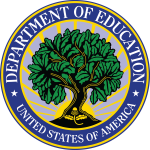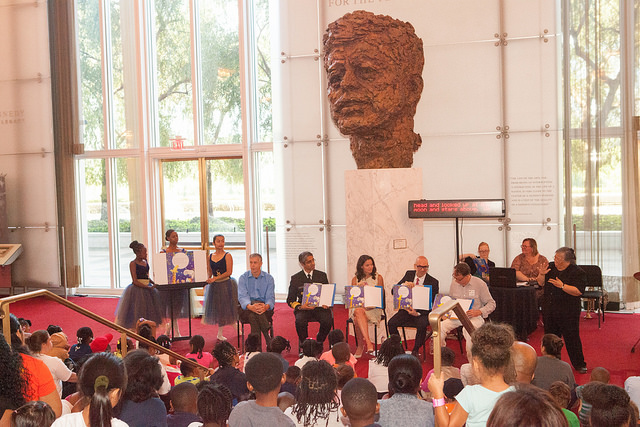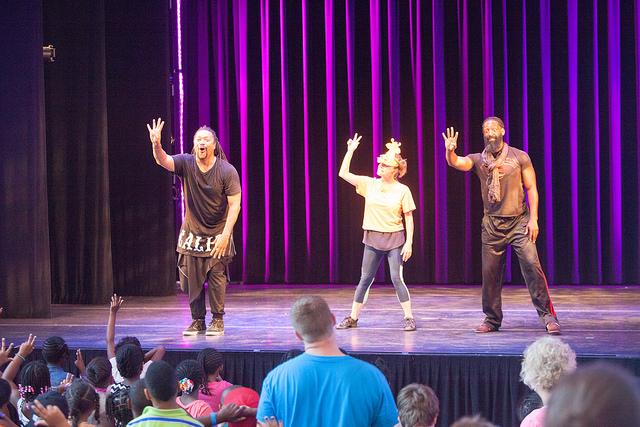The Rehabilitation Act of 1973 (Rehabilitation Act) is landmark legislation, which changed the course of services and expanded the rights of individuals with disabilities in our nation. It set out the purpose, policy and principles that have continued to guide its implementation over the past 50 years.
Category Archives: ADA
Americans with Disabilities Act
Commemorating The ADA and Announcing a New Resource to Support Students with Long COVID
Cross-posted from the Office for Civil Rights Blog
July 26, 2021
 This week, we celebrate the 31st anniversary of the Americans with Disabilities Act (ADA), a watershed civil rights law that mandated the elimination of discrimination against individuals with disabilities.
This week, we celebrate the 31st anniversary of the Americans with Disabilities Act (ADA), a watershed civil rights law that mandated the elimination of discrimination against individuals with disabilities.
Since its enactment in 1990, the ADA has played a crucial role in expanding protection against discrimination in education. Schools across the country—serving students from pre-K through graduate school—must make their offerings available and accessible to all students, including those with and without disabilities.
Call to Action: Make Disability Visible in Everything We Do
This is a cross-post of an Office of Career, Technical, and Adult Education’s Blog post.
Today, July 26, is the anniversary of the signing in 1990 of the Americans with Disabilities Act. In recognition of the spirit of the Act, we are pleased to recommit to the important work of making our programs inclusive and accessible to all.
Disability is part of the human experience, and one of the variables that contribute to the rich diversity of our nation. Disability is not a static condition—people can experience a disability from birth, or develop a disability as a result of genetics, aging, or trauma. Disability does not discriminate—anyone can acquire a disability, at any time. Individuals with disabilities are neighbors, teachers, community leaders, and parents. They are workers, managers, corporate CEOs, and healthcare providers. Individuals with disabilities can and do participate in all realms of work, and their strong participation is vital to our economic growth.
According to the American Community Survey, in 2014, the resident population in the United States was estimated to be approximately 319.9 million individuals; and of this, approximately 31.9 million individuals have some kind of disability, including both apparent and non-apparent disabilities. Yet individuals with disabilities still face barriers to full, family-sustaining employment.
On June 21, 2016, the Bureau of Labor Statistics released the Persons with a Disability: Labor Force Characteristics. The data on persons with a disability are collected as part of the Current Population Survey (CPS), a monthly sample survey of about 60,000 households that provides statistics on employment and unemployment in the United States. Based on this report, in 2015, 17.5 percent of persons with a disability were employed. The unemployment rate for persons with a disability was 10.7 percent in 2015, compared to 5.1 percent for those without a disability. Some key findings (and where to find them in the report) include:
- Among all educational attainment groups, unemployment rates were higher for persons with a disability than for those without a disability.[1] (Table 1)
- Persons with a disability are less likely to have completed a bachelor’s degree or higher than those with no disability. (Table 1)
- Across all levels of education, persons with a disability were much less likely to be employed than were their counterparts without a disability. (Table 1)
- Thirty-two percent of workers with a disability were employed part-time, compared with 18 percent for those without a disability. (Table 2)
- Persons with a disability were more heavily concentrated in service occupations than those without a disability (21.7 percent compared with 17.2 percent) and less likely to work in management, professional, and related occupations than those without a disability (31.3 percent compared with 39.2 percent). (Table 3)
- The jobless rate was higher for minorities with a disability (17.4 percent for Blacks and 13.3 percent for Hispanics) than among Whites (9.6 percent) and Asians (7.4 percent). (Table 1)
Inclusion of individuals with disabilities cannot be an afterthought. We—the Employment and Training Administration (ETA) and Office of Disability Employment Policy (ODEP) at the U.S Department of Labor (DOL), the Office of Special Education and Rehabilitative Services (OSERS)/the Rehabilitation Services Administration (RSA), and the Office of Career, Technical and Adult Education (OCTAE) at the U.S. Department of Education (ED) and our grantees—will continue to consider the experiences of individuals with disabilities, be intentional about including disability in our policy and program documents, incorporate universal design in our service delivery strategies, and continue to be inclusive in our use of language. Moreover, we will continue to ensure that youth and adults with disabilities can access our education, training, and workforce programs and successfully complete them. We will work closely with America’s employers and our local partners in the workforce development system to ensure physical, programmatic, and employment access across the board. Finally, we must continue to actively foster a culture in which individuals are supported and accepted for who they are, without fear of discrimination based on disability.
In full support of this call to action, we will make improvements to the programs we are responsible for administering in the Workforce Innovation and Opportunity Act (WIOA), the Carl D. Perkins Career and Technical Education Act, and complementary programs that affect the opportunities of individuals with disabilities. We will strengthen alignment and find new ways to provide better services to more people through close collaboration at the national, state, local, and tribal levels among our respective programs.
Significant work is already under way. OSERS/RSA, and OCTAE will soon release technical assistance resources focused on expanding access and support for individuals with disabilities in education programs under WIOA—especially through career pathways, a model endorsed by 12 federal agencies. DOL’s ODEP, ETA, and Civil Rights Center have issued a set of best practices for physical and programmatic accessibility for individuals with disabilities. Collectively, we are gathering concrete examples of promising practices, partnerships, and interventions offered by core and partner programs under WIOA. We are seeking examples of innovations focused on changing the prospects of youth and adults with disabilities, for possible inclusion in the resources. If you are aware of such efforts, please tell us about them either by emailing us at inclusion@ed.gov. In particular, we are interested in your answers to the following questions:
- How are the WIOA core and partner programs in your community creating a welcoming environment for people with visible and hidden disabilities?
- How are the WIOA core and partner programs in your community ensuring that American Job Centers and career workforce education and training services are accessible to individuals with disabilities?
- How are the WIOA core and partner programs in your community using data to effectively identify individuals with disabilities, determine customized interventions, and monitor the effectiveness of your supports?
- How are the WIOA core and partner programs using multiple funding sources to assure that individuals with disabilities have the services and supports needed to succeed?
- Can you share examples of promising career pathways programs that are improving outcomes for individuals with disabilities?
We are always looking for innovative ways to expand opportunities for individuals with disabilities through demonstration grants. Here are two key examples:
- ED has recently initiated a five-year, $3.5 million per year Career Pathways for Individuals with Disabilities (CPID) model demonstration program in Georgia, Kentucky, Nebraska, and Virginia. The purpose of the program is to demonstrate replicable promising practices in the use of career pathways: to enable VR-eligible individuals with disabilities, including youth with disabilities; to acquire marketable skills and recognized postsecondary credentials; and, to secure competitive integrated employment in high-demand, high-quality occupations. Program activities are being designed and implemented in partnership with secondary and postsecondary educational institutions, American Job Centers, workforce training providers, social and human service organizations, employers, and other Federal career pathways initiatives.
- The DOL’s Disability Employment Initiative (DEI) expands the capacity of the workforce system to improve the education, training, and employment outcomes of youth and adults with disabilities, and uses a career pathway framework to increase opportunities. DEI is funded jointly by ETA and ODEP; these agencies published a new Funding Opportunity Announcement (FOA) for a seventh round of these grants for state workforce agencies on June 27, 2016. The FOA can be found at grants.gov and it closes August 1, 2016. We encourage states to apply. The newest grantees will be announced in the coming weeks.
As a nation, we must continue to promote inclusion and to break down the barriers that remain—in hearts, in minds, in habits, and in policies—to the security and prosperity that stable jobs provide and that all people deserve. Thank you for your partnership in this important work.
- Johan E. Uvin is the Deputy Assistant Secretary, delegated the duties of the Assistant Secretary, for the Office of Career, Technical, and Adult Education.
- Sue Swenson is the Acting Assistant Secretary for the Office of Special Education and Rehabilitative Services.
- Janet L. LaBreck is the Commissioner for the Rehabilitation Services Administration.
- Portia Wu is the Assistant Secretary for the Employment Training Administration at the U.S. Department of Labor.
- Gerri Fiala is the Deputy Assistant Secretary for the Employment Training Administration at the U.S. Department of Labor.
- Jennifer Sheehy is the Deputy Assistant Secretary for the Office of Disability Employment Policy at the U.S. Department of Labor.
[1] Educational attainment data are presented for those age 25 and over.
ED’s Let’s Read! Let’s Move!
Celebrates Access to the Arts and the
25th Anniversary of the ADA.
The U.S. Department of Education’s Let’s Read! Let’s Move! Celebrates
Access to the Arts and the 25th Anniversary of the
Americans with Disabilities Act.
On July 22, 2015 the U.S. Department of Education’s Let’s Read! Let’s Move! series danced into the John F. Kennedy Center for the Performing Arts celebrating the 25th anniversary of the passing of the Americans with Disability Act (ADA), and the 40th anniversary of the Very Special Arts (VSA). Let’s Read! Let’s Move!, a sub initiative of the first Lady’s Let’s Move! program, aims to engage children between the ages of 3-7 in summer learning through reading and physical activity. On this day the theme of the event was “Dance is for Every Body.”
Over 140 children from various organizations, including the Beacon House, Edward C Mazique Parent Child Center, Lollipop Kids Foundation, Friendship Public Charter School, Montgomery County Public Schools, and Kingsbury Day School, filled the Grand Foyer and Opera House steps of the Kennedy Center where they learned that anyone can participate in the arts. This was especially evident through various guests and performers throughout the day.
A trio of ballerinas from the Washington Ballet @THEARC Performance Ensemble gracefully guided Secretary Duncan and his friends into the Grand Foyer. His friends included White House Executive Director of Let’s Move! Deb Eschmeyer, Surgeon General Vice Admiral Vivek Murthy, Mario Rossero, Vice President of Education at the Kennedy Center, and Lawrence Carter-Long, a performer in Heidi Latsky’s critically-acclaimed GIMP dance troupe. With the ballerinas holding up large-print pages, they read a book titled Giraffes Can’t Dance by Giles Andreae and illustrator Guy Parker-Rees about Gerald the Giraffe who did not dance like the rest of the animals. However, he learned to dance to his own beat. Mr. Carter-Long, an internationally-recognized dancer with cerebral palsy, talked about his connection with Gerald in that they “both had wobbly knees.” He then showed off the brace on his leg. When a child asked the readers “How do you find the right music for you?” he answered, “You’ve got to listen to it and feel it inside of you.” In closing the Let’s Read! part of the event, Ms. Eschmeyer asked the children what they did for exercise, which had many shouting activities such as running, football, basketball, soccer, and dance.
Afterwards, the Surgeon General, along with the ballerinas and other guests, led the children to the Millennium Stage, where he was joined by a bhangra dance troupe, Dholi Ram. After teaching them several moves, children of all abilities joined in a mini bhangra flash mob to Bruno Mars’ “Uptown Funk.”
Continuing the Let’s Move! portion of the event, Septime Webre, artistic director of the Washington Ballet, helped the children “create a ballet” using everyday morning actions such as brushing your teeth, getting out of bed, eating your cereal, etc. Kennedy Center Dance Teaching Artists, Alison Crosby, Fred Beam, and Antoine Hunter, both of whom are deaf and used interpreters to communicate with the children, brought the event full circle by leading the children in a jungle jamboree, where, following the story they heard, they “waltzed like warthogs, rock ‘n rolled like rhinos, tangoed like lions” and most of all, learned to dance to their own beat, just like Gerald.
OSERS Celebrates ADA
In celebration of the 25th anniversary of the passage of the Americans with Disabilities Act (ADA) in 1990, the Office of Special Education and Rehabilitative Services (OSERS) is excited to announce accomplishments aimed at improving the lives of and expanding opportunities for people with disabilities.
First, just today at the Department’s 25th ADA Celebration, OSERS Assistant Secretary Michael Yudin highlighted a timely new funding announcement:
Accessibility of Computers and Web Sites—Automated Personalization Computing Project (APCP)
Today, OSERS announced a new funding opportunity, the Accessibility of Computers and Web Sites through an Automated Personalization Computing Project (APCP), to create the infrastructure we need to make it easier for any person of any age with any disability to more easily use any web enabled device at school, at home, at work, or in the community. This funding opportunity, totaling up to $20 million over five years, will implement a pilot demonstration of automated personalization for individuals with disabilities who are using information and communication technologies. Individuals with disabilities will be able to access communications and information technology on a secure basis no matter where they are (at school, work, home, or in the community), what kind of computer they work on (e.g., desktop, laptop, tablet, smartphone, kiosk) or what software platform (e.g., PC, Mac, Android, iOS) they are using, as long as it is an APCP-enabled computer with Web access. OSERS is looking forward to receiving and evaluating applications and making the award by the end of this September, 2015.
Additional OSERS ADA Achievements
Increasing Workforce Services for People with Disabilities
In July 2014, President Obama signed the Workforce Innovation and Opportunities Act (WIOA), which seeks to improve the nation’s workforce development system and strengthens the services provided by the 2,500 American Job Centers to workers, employers and job seekers. WIOA reauthorized the 3.4 billion dollar Vocational Rehabilitation Program, which provides employment supports and training to one million individuals each year seeking high quality employment. WIOA established the Advisory Committee on Increasing Competitive Integrated Employment for Individuals with Disabilities. All three agencies responsible for implementing WIOA—the Departments of Labor, Education, and Health and Human Services—have taken strides to ensure that people with disabilities have improved access to services and employment outcomes.
“Know It 2 Own It”
OSERS has featured a “Know It 2 Own It” Blog every month over the past year leading up to the 25th Anniversary of the ADA the U.S. Department of Education’s main Homeroom Blog. “Know It 2 Own It” is a campaign that featured monthly stories to encourage the general public to learn more about the disability rights movement and history that led to the passage of the ADA.
Awarding Grants to Help Individuals with Disabilities Obtain Employment
In 2014, OSERS’ Rehabilitation Services Administration (RSA) awarded a five-year, $9 million grant to the Institute for Community Inclusion at the University of Massachusetts, Boston for a Job-Driven Vocational Rehabilitation Technical Assistance Center. Also in 2014, OSERS’ Office of Special Education and Rehabilitative Services (OSEP) and RSA funded a joint Technical Assistance Center, the National Technical Assistance Center on Transition (NTACT), to improve postsecondary and employment outcomes for all students with disabilities.
Promoting the Readiness of Minors who Receive Supplemental Security Income (PROMISE)
The Office of Special Education and Rehabilitative Services (OSERS) administers PROMISE, a $211 million program. PROMISE is an interagency collaboration of the Departments of Education, Health and Human Services, Labor and the Social Security Administration, is a 5-year grant program under which state agencies have partnered to develop and implement six model demonstration projects that provide coordinated services and supports designed to improve the education and career outcomes of children with disabilities who receive supplemental security income in eleven states.
Ensuring Results-Driven Accountability Under the Individuals with Disabilities Education Act (IDEA)
Over the past several years, OSERS has implemented a revised accountability system under the IDEA known as Results-Driven Accountability, which shifts efforts from a primary emphasis on compliance to a framework that focuses on improved results for students with disabilities, including performance on assessments, graduation rates, and early childhood outcomes.
Supporting Accessible Books
OSERS supports Bookshare, the world’s largest collection of accessible titles online. The service is free to students who are blind, visually impaired, or certified as having a print disability. Bookshare has a total of 301,000 education titles with 350,000 students with its services. In addition, the Administration participated in the successful negotiation of the Marrakesh Copyright Treaty to increase access to print materials for the world’s estimated 340 million blind, visually impaired, and other persons with print disabilities. The United States played a leadership role in negotiating this treaty, which should help reduce the global shortage of print materials in accessible formats such as Braille, large print, and accessible digital files, while maintaining the integrity of the international copyright framework.
Bookshare is also working to ensure image that descriptions are also shown in Bookshare titles, increasing their accessibility working through the DIAGRAM Center, a research and development center whose goal is to improve the way image and graphic content for accessible instructional materials (AIM) is produced and accessed so that students with print disabilities are provided equal access to the general education curriculum.
Supporting Inclusive Schoolwide Reform
In 2012, the OSERS awarded a five year $25 million grant to the SWIFT Center to assist states and local school districts successfully implement and sustain inclusive schoolwide reform in kindergarten through grade 8. The SWIFT Center provides intensive technical assistance to improve the practices within schools that lead to success for all students, including those with disabilities and the most intensive support needs.
Correctional Education in Juvenile Justice Facilities
In 2014, OSERS, in partnership with the Office for Civil Rights and the U.S. Department of Justice issued comprehensive guidance supporting the civil rights and educational needs of students with disabilities in juvenile justice facilities.
Guidance on Keeping Students with Disabilities Safe from Bullying
In 2013, OSERS issued guidance regarding the bullying of students with disabilities. The guidance makes clear that the bullying of a student with a disability that results in the student not receiving meaningful educational benefit constitutes a denial of a free appropriate public education (FAPE) under the IDEA that must be remedied.
Guidance on Braille Instruction
In 2013, OSERS issued guidance affirming the importance of Braille instruction as a literacy tool for blind and visually impaired students, clarifies the circumstances in which Braille instruction should be provided, and reiterates the scope of an evaluation required to guide decision of Individualized Education Program (IEP) teams in this area. Additionally, the guidance identifies resources that are designed to help strengthen the capacity of the state and local personnel to meet the needs of students who are blind or visually impaired.
Effective Communication
A November 12, 2014 joint guidance and accompanying FAQ by OSERS, the Office of Civil Rights, and the U.S. Department of Justice, ensuring educational agencies understand the different requirements under IDEA and the ADA and its Section 504 with respect to children with a hearing, vision, or speech disability. While IDEA requires that schools make available free appropriate public education (FAPE), consisting of special education and related services, Title II has a specific effective communication requirement for individuals with disabilities – requiring schools to ensure that students with disabilities receive communication that is as effective as communication with others through the provision of appropriate auxiliary aids and services.
Personnel Prep
OSERS Office of Special Education Programs (OSEP) currently supports 28 personnel development programs that prepare professionals to provide special instruction for children with visual impairment and blind.
Examples of work topics and products include:
- working to develop standard measures and competencies for completing braille course work in the Unified English Braille Code (UEB),
- development of CEC standards for teachers of the visually impaired, and
- a survey of the university programs on curricula in technology, requirements, measures of competency, and more.
Media & Technology Services
Video-on-Demand Children’s TV Programming Now Accessible for Thousands of Students with Visual or Hearing Disabilities.
The Accessible Television Portal project opens access to free, video-on-demand children’s television programming for thousands of students who are blind, visually impaired, deaf or hard of hearing.
Some projects in this area are designed to support the education of children with sensory disabilities by providing support for captioning and video description of educational materials that are appropriate for use in educational environments.
Stepping Up Technology Implementation.
Stepping up projects support efforts to scale up the use of existing, technologies and accompanying instructional strategies in educational environments. An example is: Improving Literacy and Technology Skills Using the Braille Challenge Mobile at the California State University, Los Angeles (CSULA), and the Braille Institute of America (BIA). The main goal of the project is to support the development of literacy skills of children who read braille by creating and disseminating a mobile app, the Braille Challenge Mobile App (BCMA), and incorporating evidence-based instructional strategies and supporting the development of reading and writing skills.
Also, please check out the:
-
- White House’s ADA Fact Sheet








